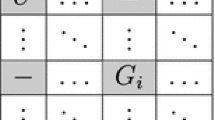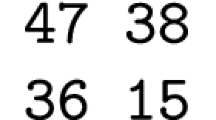Abstract
For an ordering of the blocks of a design, the point sum of an element is the sum of the indices of blocks containing that element. Block labelling for popularity asks for the point sums to be as equal as possible. For Steiner systems of order v and strength t in general, the average point sum is \(O(v^{2t-1})\); under various restrictions on block partitions of the Steiner system, the difference between the largest and smallest point sums is shown to be \(O(v^{(t+1)/2}\log v)\). Indeed for Steiner triple systems, direct and recursive constructions are given to establish that systems exist with all point sums equal for more than two thirds of the admissible orders.

Similar content being viewed by others
References
Abel R.J.R., Lamken E.R., Wang J.: A few more Kirkman squares and doubly near resolvable BIBDs with block size 3. Discret. Math. 308(7), 1102–1123 (2008).
Alon N., Spencer J.H.: The Probabilistic Method. Wiley, Hoboken, NJ (2008).
Anderson I.: Some 2-rotational and cyclic designs. J. Combin. Des. 4(4), 247–254 (1996).
Anstice R.R.: On a problem in combinations. Camb. Dublin Math. J. 7, 279–292 (1852).
Anstice R.R.: On a problem in combinations (continued). Camb. Dublin Math. J. 8, 149–154 (1853).
Bermond J.C., Jean-Marie A., Mazauric D., Yu J.: Well-balanced designs for data placement. J. Combin. Des. 24(2), 55–76 (2016).
Beth T., Jungnickel D., Lenz H.: Design Theory. Vol. I, Encyclopedia of Mathematics and Its Applications, vol. 69, 2nd edn Cambridge University Press, Cambridge (1999).
Bose R.C.: On the construction of balanced incomplete block designs. Ann. Eugen. 9(4), 353–399 (1939).
Buratti M., Ghinelli D.: On disjoint \((3t,3,1)\) cyclic difference families. J. Stat. Plann. Inference 140(7), 1918–1922 (2010).
Buratti M., Zuanni F.: \(G\)-invariantly resolvable Steiner \(2\)-designs which are \(1\)-rotational over \(G\). Bull. Belg. Math. Soc. Simon Stevin 5(2–3), 221–235 (1998).
Buratti M., Zuanni F.: Explicit constructions for 1-rotational Kirkman triple systems. Util. Math. 59, 27–30 (2001).
Chee Y.M., Colbourn C.J., Dau H., Gabrys R., Ling A.C.H., Lusi D., Milenkovic O.: Access balancing in storage systems by labeling partial Steiner systems. Des. Codes Cryptogr. 88, 2361–2376 (2020).
Chernoff H.: A note on an inequality involving the normal distribution. Ann. Probab. 9(3), 533–535 (1981).
Chung F., Lu L.: Concentration inequalities and martingale inequalities: a survey. Internet Math. 3(1), 79–127 (2006).
Cohen M.B., Colbourn C.J.: Optimal and pessimal orderings of Steiner triple systems in disk arrays. Theor. Comput. Sci. 297(1–3), 103–117 (2003).
Colbourn C.J.: Separations of Steiner triple systems: some questions. Bull. ICA 6, 53–56 (1992).
Colbourn C.J.: Popularity block labelling for Steiner systems. In: Seventeenth International Workshop on Algebraic and Combinatorial Coding Theory (ACCT2020), pp. 41–46 (2020)
Colbourn C.J.: Egalitarian edge orderings of complete graphs. Graphs Combin. 37(4), 1405–1413 (2021).
Colbourn C.J., Hoffman D.G., Rees R.: A new class of group divisible designs with block size three. J. Combin. Theory Ser. A 59(1), 73–89 (1992).
Colbourn C.J., Horsley D., Wang C.: Trails of triples in partial triple systems. Des. Codes Cryptogr. 65(3), 199–212 (2012).
Colbourn C.J., Lamken E.R., Ling A.C.H., Mills W.H.: The existence of Kirkman squares–doubly resolvable \((\nu,3,1)\)-BIBDs. Des. Codes Cryptogr. 26(1–3), 169–196 (2002).
Colbourn C.J., Rosa A.: Triple Systems. Oxford Mathematical Monographs. Clarendon Press, Oxford (1999).
Dau H., Milenkovic O.: MaxMinSum Steiner systems for access balancing in distributed storage. SIAM J. Discret. Math. 32(3), 1644–1671 (2018).
Dewar M., Stevens B.: Ordering Block Designs: Gray Codes, Universal Cycles and Configuration Orderings CMS Books in Mathematics/Ouvrages de Mathématiques de la SMC. Springer, New York (2012).
Dinitz J.H., Rodney P.: Disjoint difference families with block size \(3\). Util. Math. 52, 153–160 (1997).
Dinitz J.H., Shalaby N.: Block disjoint difference families for Steiner triple systems: \(v\equiv 3\,\text{ mod }\,6\). J. Stat. Plann. Inference 106(1–2), 77–86 (2002).
Feng T., Horsley D., Wang X.: Novák’s conjecture on cyclic Steiner triple systems and its generalization (2020)
Grannell M..J.., Griggs T..S.: Product constructions for cyclic block designs. I. Steiner quadruple systems. J. Combin. Theory Ser. A 36(1), 56–65 (1984).
Guregová M., Rosa A.: Using the computer to investigate cyclic Steiner quadruple systems. Mat. Časopis Sloven. Akad. Vied 18, 229–239 (1968).
Hanani H.: A note on Steiner triple systems. Math. Scand. 8(1), 154–156 (1960).
Hartman A.: The existence of resolvable Steiner quadruple systems. J. Combin. Theory Ser. A 44(2), 182–206 (1987).
Hedayat A.S., Sloane N.J.A., Stufken J.: Orthogonal Arrays. Springer, New York (1999).
Ji L., Zhu L.: Resolvable Steiner quadruple systems for the last 23 orders. SIAM J. Discrete Math. 19(2), 420–430 (2005).
Longyear J.Q.: Nested group divisible designs and small nested designs. J. Stat. Plann. Inference 13(1), 81–87 (1986).
Lu J.X.: Construction methods for balanced incomplete block designs and resolvable balanced incomplete block designs (in Chinese). In: L. Wu, L. Zhu, Q. Kang (eds.) Collected Works of Jiaxi Lu, pp. 1–24. Inner Mongolia People’s Press, Hunhot, Mongolia (1990). Unpublished (1965).
Lu X.N., Jimbo M.: Affine-invariant strictly cyclic Steiner quadruple systems. Des. Codes Cryptogr. 83(1), 33–69 (2017).
Mathon R.A., Phelps K.T., Rosa A.: Small Steiner triple systems and their properties. Ars Combin. 15, 3–110 (1983).
Meng Z.: Doubly resolvable Steiner quadruple systems and related designs. Des. Codes Cryptogr. 84(3), 325–343 (2017).
Meng Z., Du B.: The last twenty orders of \((1,2)\)-resolvable Steiner quadruple systems. Discret. Math. 312(24), 3574–3584 (2012).
Mood A.M.F., Graybill F.A., Boes D.C.: Introduction to the Theory of Statistics. McGraw-Hill, Chennai (1974).
Novák J.: A note on disjoint cyclic Steiner triple systems. In: Recent advances in graph theory (Proceedings Second Czechoslovak Symposium, Prague, 1974), pp. 439–440 (1975)
Peltesohn R.: Eine Lösung der beiden Heffterschen Differenzenprobleme. Compos. Math. 6, 251–257 (1939).
Phelps K.T., Rosa A.: Steiner triple systems with rotational automorphisms. Discret. Math. 33(1), 57–66 (1981).
Ray-Chaudhuri D.K., Wilson R.M.: Solution of Kirkman’s schoolgirl problem. In: Combinatorics (Proceedings of Symposium Pure Mathematics, Vol. XIX, University California, Los Angeles, CA, 1968), pp. 187–203 (1971).
Siemon H.: Cyclic Steiner quadruple systems and Köhler’s orbit graphs. Des. Codes Cryptogr. 1(2), 121–132 (1991).
Skolem T.: Some remarks on the triple systems of Steiner. Math. Scand. 6, 273–280 (1959).
Stewart B.M.: Supermagic complete graphs. Can. J. Math. 19, 427–438 (1967).
Stinson D.R.: Combinatorial Designs. Constructions and Analysis. Springer, New York (2004).
Vanstone S.A., Stinson D.R., Schellenberg P.J., Rosa A., Rees R.S., Colbourn C.J., Carter M.W., Carter J.E.: Hanani triple systems. Israel J. Math. 83(3), 305–319 (1993).
Wei H., Ge G., Colbourn C.J.: The existence of well-balanced triple systems. J. Combin. Des. 24(2), 77–100 (2016).
Yu W., Zhang X., Ge G.: Optimal fraction repetition codes for access-balancing in distributed storage. IEEE Trans. Inf. Theory 67(3), 1630–1640 (2021).
Acknowledgements
Thanks to Yeow Meng Chee, Dylan Lusi, and Olgica Milenkovic for helpful discussions.
Author information
Authors and Affiliations
Corresponding author
Additional information
Communicated by D. Ghinelli.
Publisher's Note
Springer Nature remains neutral with regard to jurisdictional claims in published maps and institutional affiliations.
The work was supported by NSF Grant CCF 1816913.
Rights and permissions
About this article
Cite this article
Colbourn, C.J. Egalitarian Steiner triple systems for data popularity. Des. Codes Cryptogr. 89, 2373–2395 (2021). https://doi.org/10.1007/s10623-021-00925-0
Received:
Revised:
Accepted:
Published:
Issue Date:
DOI: https://doi.org/10.1007/s10623-021-00925-0




